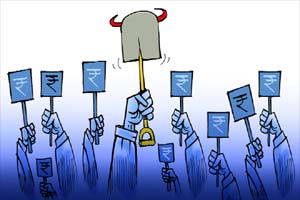Indian politicians are infamous for their rhetoric and tall claims! If there was a book on recent history, as you flip through the pages, reading what politicians said in the past, it is difficult not to shake your head and wonder, “What were they thinking!”.
Through some strange twist of fate, a number of these politicians gained their entry in the hallowed portals of the ministry of telecommunication—the most recent one was former minister Kapil Sibal, with his “zero-loss” claim in the face of the biggest telecom scam ever.
The recent successful auctions of spectrum and coal-blocks are significant metaphors of how far the country and its governance have come. The change in the government’s approach towards these public assets is a transformation and it is useful to remind ourselves of how we got here from where we were.
Way back in May 2007, when, as a new MP, I started raising the issue of spectrum auctions, I was dismissed as a former telecom entrepreneur who had an axe to grind. Despite repeated efforts, there was little or no support for auctions as the best way to deal with spectrum requirements. Expectedly, the opposition to this from the industry was fierce since the players were being asked to pay more. But strangely, many ‘experts’ in the media opposed it, based on the theory that this would drive up prices for consumers, despite no evidence or economics supporting this. It was then, as it remains now, evidence of how easy it was for corporate interests to influence many business journalists—something which later events have also shown!
However, for all the heavy forces aligned against this, there were many (including in the media and the government) who were trying to focus the spotlight on this dysfunction and brazen loot. I started writing about auctions as the right allocation method in letters to the govern- ment—one was dated November 14, 2007, even before the UPA started its licence-granting spree. I wrote “all decisions relating to spectrum allocation must pass the twin tests of public interest and transparency to the fullest” and “that in any allocation of spectrum (it was known that fresh licenses would be issued in the next few months) two questions were critical. First, why was the government charging a price that was discovered through a tender process six years ago in 2001? Second, why were issue of licences not following a tender (akin to auction) route?” On November 26, 2007, I wrote to the then telecom minister, A Raja, and I finessed the above issues. I asked for a commitment from the minister that “DoT will immediately amend the existing policy and the 2005 guidelines to ensure that all future licences/spectrum shall only be through an open, transparent multi-round bidding process.”
And on September 25, 2008 I wrote that “there is a need for a comprehensive public policy when it comes to commercial terms of monetisation of public assets like spectrum, minerals, natural resources, etc, i.e., a public policy that should be based on a simple objective and test of ensuring maximum benefits to the exchequer and public.” The lack of interest in the media at that time astounds me to date. There were a few journalists who wrote bravely about this—running counter to the love-affair that the media was having then with the UPA government.
The real catalyst, however, was the November 2010 report of the CAG. This work by the CAG is a landmark in the history of Indian governance.
The media could no longer ignore the issue—causing a series of actions like the PILs and Supreme Court orders that had the cumulative effect of getting the nation talking about this—and with that the status quo had been demolished once in for all. It was in the face of all this that Sibal tried his doomed-to-fail ‘zero-loss’ theory.
A few years on, history repeated itself when the coal-block scam exploded and, without learning from the past, the then finance minister, P Chidambaram, tried his ‘coal is in the mother earth’ theory to debunk CAGs coal report. I have no doubt that both these ministers, with their terrible defences, further accelerated the process of the courts’ intervention.
The Supreme Court’s decision on the 2G PIL and its order on the Presidential reference put to it by Sibal et al, further created the framework that is in play today. In early 2012, the Supreme Court judgment ordering the cancellation of telecom licences noted, “Natural resources belong to the people but the State legally owns them on behalf of its people and from that point of view natural resources are considered as national assets…. However, as they constitute public property/national asset, while distributing natural resources, the State is bound to act in consonance with the principles of equality and public trust and ensure that no action is taken which may be detrimental to public interest.” It added that auction was the best way to allocate natural resources, be it oil and gas, spectrum, minerals and coal.
So, a process that started in 2007 with myriad twists and turns and plenty of obfuscation, denial and push back, ends with the current successful spectrum and coal-block auctions. These auctions are a slap in the face of all those that opposed auctions all these years. They have earned over R3 lakh crore for the government but, more importantly, made the process transparent and equitable. Think, and think again, what would have happened if auctions weren’t there! This money would have gone to the account of a few businessmen and their political friends, instead of adding to the kitty of public money—for investment in health, education, social security, poverty alleviation programmes. R3 lakh crore is what you get if you are a government doing the right thing!
The author is a member of Parliament and a tech entrepreneur. E-mail: rajeev.c@nic.in

